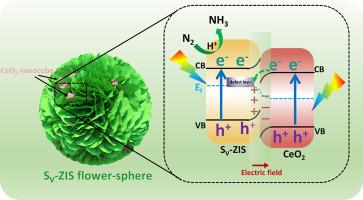CeO2 nanocubes-embedded sulfur-deficient ZnIn2S4 flower-sphere S-scheme systems for sustainable ammonia production in pure water
IF 14.3
1区 材料科学
Q1 MATERIALS SCIENCE, MULTIDISCIPLINARY
引用次数: 0
Abstract
Despite its industrial dominance, the century-old Haber–Bosch process for ammonia (NH3) synthesis suffers from sustainability issues stemming from high energy consumption and significant carbon emissions. Photocatalytic nitrogen fixation presents a promising alternative but is hindered by rapid charge recombination, poor N2 activation, and limited environmental adaptability. Herein, we report a sulfur vacancy (SV)-rich ZnIn2S4/CeO2 S-scheme heterojunction, synthesized via a one-pot solvothermal method, that integrates dual engineering of defects and interfacial charge modulation. Characterized by femtosecond transient absorption (fs-TA) spectroscopy and electrostatic potential calculations, the S-scheme charge transfer establishes an interfacial built-in electric field (BEF) that spatially separates charge carriers while preserving strong redox potentials. Moreover, the sulfur vacancies serve as electron-rich sites, lowering the energy barrier for N N dissociation and extending light absorption into the near-infrared region. Isotopic labeling confirms atmospheric N2 as the nitrogen source for NH3 production, while in situ diffuse reflectance infrared Fourier transform spectroscopy (DRIFTS) monitors key *NHX intermediate formation.The optimized heterojunction photocatalyst achieves an NH3 production rate of 462 μmol g−1 h−1 in N2 atmosphere and maintains 27% efficiency (123 μmol g−1 h−1) in air.This work provides a universal strategy for designing defect-coupled heterojunctions that reconcile high efficiency with environmental robustness, paving the way for sustainable solar-driven ammonia synthesis.
N dissociation and extending light absorption into the near-infrared region. Isotopic labeling confirms atmospheric N2 as the nitrogen source for NH3 production, while in situ diffuse reflectance infrared Fourier transform spectroscopy (DRIFTS) monitors key *NHX intermediate formation.The optimized heterojunction photocatalyst achieves an NH3 production rate of 462 μmol g−1 h−1 in N2 atmosphere and maintains 27% efficiency (123 μmol g−1 h−1) in air.This work provides a universal strategy for designing defect-coupled heterojunctions that reconcile high efficiency with environmental robustness, paving the way for sustainable solar-driven ammonia synthesis.

CeO2纳米立方包埋的缺硫ZnIn2S4花球s方案体系在纯水中可持续制氨
尽管在工业上占据主导地位,但由于高能耗和大量碳排放,具有百年历史的氨(NH3)合成Haber-Bosch工艺存在可持续性问题。光催化固氮是一种很有前途的替代方法,但由于电荷重组快、N2活化差和环境适应性有限而受到阻碍。在此,我们报道了一个富含硫空位(SV)的ZnIn2S4/CeO2 S-scheme异质结,通过一锅溶剂热法合成,集成了缺陷的双重工程和界面电荷调制。通过飞秒瞬态吸收(fs-TA)光谱和静电势计算表征,S-scheme电荷转移建立了一个界面内置电场(BEF),在空间上分离电荷载流子,同时保持强氧化还原电位。此外,硫空位充当富电子位置,降低了神经网络解离的能量势垒,并将光吸收扩展到近红外区域。同位素标记证实大气N2是NH3生产的氮源,而原位漫反射红外傅立叶变换光谱(DRIFTS)监测关键的NHX中间地层。优化后的异质结光催化剂在N2气氛下NH3的产率为462 μmol g−1 h−1,在空气中NH3的产率为123 μmol g−1 h−1,达到27%。这项工作为设计缺陷耦合异质结提供了一种通用策略,可以调和高效率和环境稳健性,为可持续的太阳能驱动氨合成铺平道路。
本文章由计算机程序翻译,如有差异,请以英文原文为准。
求助全文
约1分钟内获得全文
求助全文
来源期刊

Journal of Materials Science & Technology
工程技术-材料科学:综合
CiteScore
20.00
自引率
11.00%
发文量
995
审稿时长
13 days
期刊介绍:
Journal of Materials Science & Technology strives to promote global collaboration in the field of materials science and technology. It primarily publishes original research papers, invited review articles, letters, research notes, and summaries of scientific achievements. The journal covers a wide range of materials science and technology topics, including metallic materials, inorganic nonmetallic materials, and composite materials.
 求助内容:
求助内容: 应助结果提醒方式:
应助结果提醒方式:


